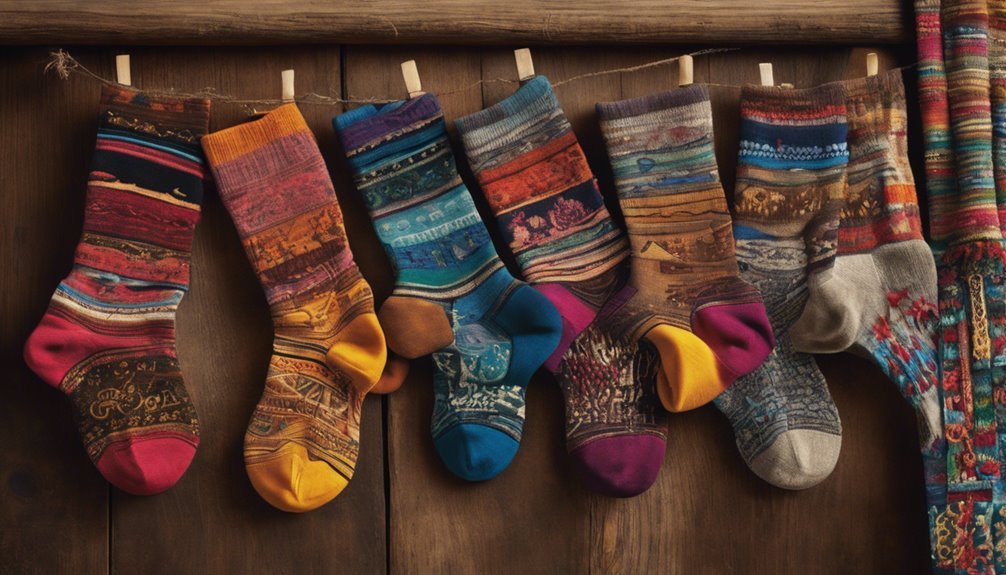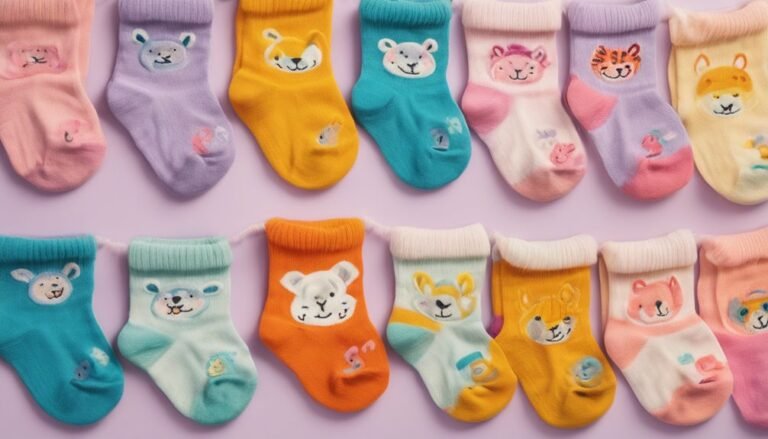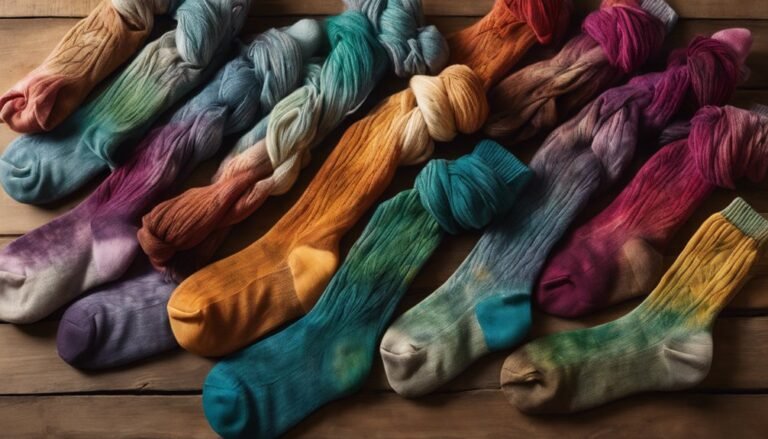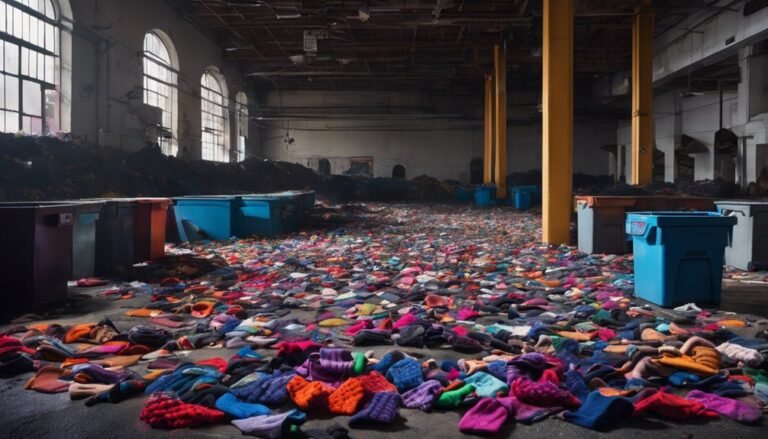The Fascinating History of Socks: From Ancient Egypt to Modern Fashion
Have you ever noticed how something as simple as socks can tell a story spanning thousands of years?
Picture this: In ancient Egypt, vibrant colored socks were not just a fashion statement but a symbol of status.
Fast forward to today, and socks have transformed from humble foot coverings made of wool and cotton to modern marvels of technology, offering both functionality and sustainability.
The Industrial Revolution brought mechanized knitting, making socks more accessible and diverse than ever before.
World Wars spurred innovations in durability, while post-war fashion embraced bold patterns.
Nowadays, technological advancements enable socks to not only reflect personal style but also blend tradition with modernity.
So, what if your socks could talk—what stories would they tell?
Early Beginnings: Socks in Ancient Civilizations
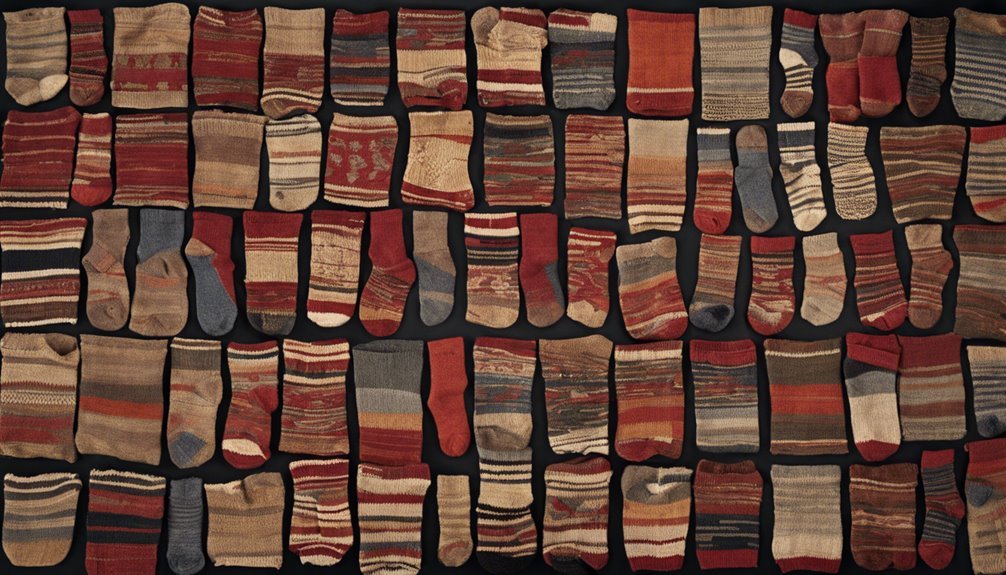
Though often overlooked in the tapestry of human innovation, socks have a storied past that traces back to ancient civilizations. Imagine stepping into the shoes—or rather, socks—of an Egyptian or Roman citizen. You'd find yourself donning ancient sock designs crafted from animal skins or woven fabrics, each reflecting a unique cultural significance. In ancient Egypt, socks were often dyed in vibrant colors, symbolizing status and wealth, while Romans embraced thicker designs for warmth and comfort. These early iterations weren't mere foot coverings but expressions of identity and status. As you explore this history, envision how these designs weren't confined by modern constraints but instead celebrated individuality. It's fascinating to see how socks, simple yet profound, were integral to cultural expression.
The Evolution of Sock Materials and Techniques
As we leave the intricate world of ancient civilizations behind, it's intriguing to contemplate how the evolution of sock materials and techniques reflects broader technological advancements and cultural shifts. You might think about how ancient wool and cotton gave way to today's sustainable materials, like bamboo and recycled polyester, reflecting a collective desire for environmentally responsible choices. This evolution mirrors society's shift towards sustainability, offering you the freedom to choose eco-friendly options.
Knitting techniques have also evolved dramatically. From hand-knitted socks of the past to modern machine knitting, these advancements have allowed for greater precision and variety in designs. The rise of circular knitting machines has made it possible for you to enjoy seamless socks, offering both comfort and style in your daily life.
Socks as a Symbol of Status and Wealth
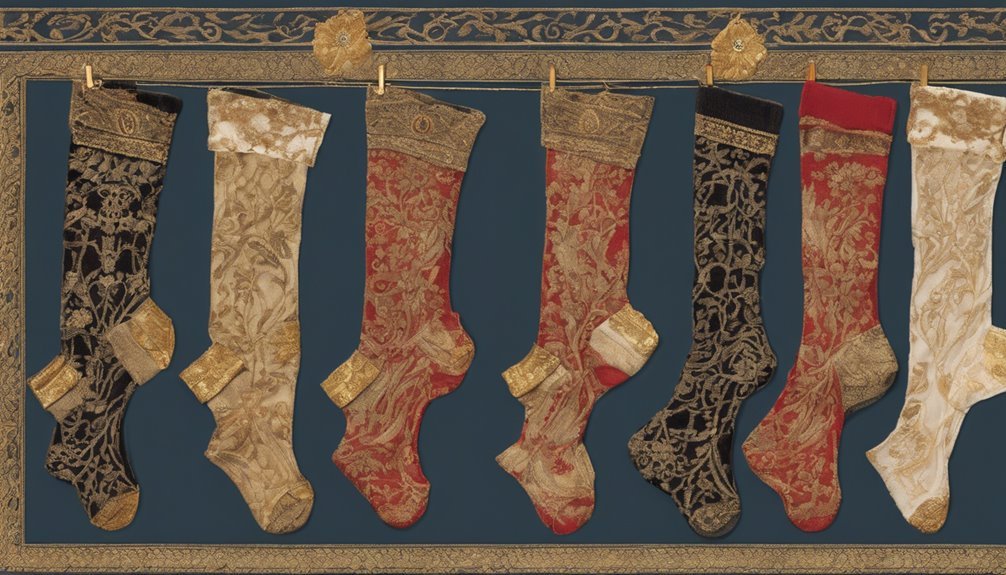
When you consider the historical context of sock materials, it becomes clear that luxury fibers like silk were exclusive to the wealthy, serving as a tactile symbol of status. The color of socks also played a significant role; vibrant hues were often reserved for the elite due to the expense and rarity of certain dyes. In this way, socks were not just practical garments but markers of social hierarchy and wealth.
Historical Sock Materials
Throughout history, the materials used to make socks have been a reflection of social hierarchies and economic status. You might find it fascinating that the type of fabric used in your socks once indicated your place in society. Consider these points:
- Cotton Origins: In ancient Egypt, cotton was a luxury. Reserved for the elite, its soft texture and breathability were highly prized. Owning cotton socks was a clear sign of wealth.
- Wool Varieties: In medieval Europe, wool became a staple for warmth. However, the quality varied considerably, with finer wool reserved for the affluent.
- Silk Extravagance: During the Renaissance, silk socks emerged as the ultimate symbol of opulence. Only the wealthiest could afford such extravagance, showcasing their status.
These materials weren't just practical; they were status symbols, too.
Sock Color Significance
While materials played a significant role in sock symbolism, color also became a potent indicator of status and wealth. Throughout history, sock color symbolism has been a subtle yet powerful tool to convey one's place in society. In ancient Rome, only the elite wore red socks, a privilege that underscored their high standing. Similarly, during the European Renaissance, vibrant hues like purple and gold were reserved for royalty, reinforcing the cultural sock meanings tied to power and opulence.
For you, understanding these cultural sock meanings offers a glimpse into how societies have used color to communicate hierarchy. It's a reminder of the freedom to choose what you wear today, unrestricted by class or status, making every color a personal statement rather than a societal decree.
The Industrial Revolution and the Mass Production of Socks
As the Industrial Revolution unfolded, it marked a pivotal shift in the production of everyday items, including socks. Sock manufacturing experienced profound changes due to textile advancements. You might appreciate how the introduction of mechanized knitting machines revolutionized the industry. These machines allowed for mass production, making socks more accessible and affordable. Consider the following key impacts:
- Efficiency: Machines could produce socks faster than traditional methods, reducing labor costs and time.
- Variety: Innovations in textile technology enabled the creation of diverse sock designs and materials, enriching consumer choices.
- Availability: Mass production made socks widely available to various social classes, no longer a luxury for the affluent.
This era empowered individuals with more choices, aligning with the desire for personal freedom and expression.
The Impact of World Wars on Sock Design and Production

During the World Wars, sock design and production were profoundly shaped by military requirements and material scarcities. You'd notice that innovations arose from the need for durable, functional socks that could withstand harsh conditions, leading to the development of new materials and knitting techniques. Post-war, these innovations didn't just fade away; they influenced civilian fashion, with practical designs becoming integrated into everyday wear.
Military Needs and Innovations
The exigencies of wartime often drive innovation, and sock design during the World Wars was no exception. Faced with harsh conditions, military innovations in tactical socks became vital. Soldiers needed reliable socks for long marches, wet trenches, and various climates. Here's how the World Wars impacted sock design:
- Durability: Military socks were designed to withstand wear and tear, ensuring they wouldn't fall apart under pressure.
- Moisture Management: Implementing materials that kept feet dry was essential, reducing the risk of trench foot, a common ailment.
- Insulation: Tactical socks evolved to provide warmth without bulk, allowing soldiers to maintain mobility in cold environments.
These advancements not only served military needs but also influenced civilian sock design, giving you more comfortable and practical options today.
Material Shortages and Solutions
While the World Wars spurred advancements in sock functionality, they simultaneously posed significant challenges due to material shortages. Key materials like wool and cotton were redirected to military efforts, straining the supply chain. You'd find manufacturers scrambling to maintain production, leading to innovative solutions. Enter alternative materials. Rayon, a synthetic substitute, emerged as a practical option despite its limitations in durability.
Analyzing these times, you see a shift in priorities—functionality over luxury, necessity over abundance. War economies demanded adaptive thinking. Factories streamlined processes, optimizing limited resources. World War challenges forced creative problem-solving, where ingenuity became essential to meet demands. This era taught industries resilience, revealing the importance of flexibility in overcoming disruptions, a lesson that resonates with those who value freedom today.
Post-War Fashion Influence
As the world emerged from the shadows of war, the influence on sock design and production became evident, reflecting societal shifts towards optimism and renewal. Post-war trends saw a fashion revival that embraced bold colors and patterns, symbolizing a break from austerity. You'd notice socks becoming an avenue for self-expression and individuality.
Consider these key changes:
- Materials: Wartime rationing ended, allowing for innovative textiles like nylon, enhancing durability and comfort.
- Designs: Geometric patterns and vibrant hues became popular, marking a departure from utilitarian designs.
- Production: Technological advancements in manufacturing allowed for mass production, making stylish socks accessible to all.
These shifts weren't just about aesthetics; they mirrored a broader societal desire for freedom and creativity.
The Rise of Socks in Fashion and Popular Culture
Although often overlooked in discussions about fashion, socks have quietly risen to prominence as a statement piece in both style and popular culture. You've probably noticed how sock trends have evolved from plain and functional to vibrant and eye-catching. This shift is partly driven by celebrity endorsements, where influencers and stars showcase unique designs, turning simple socks into must-have items. Whether it's bold patterns or whimsical graphics, socks now serve as a canvas for self-expression.
Fashion brands have also embraced this change, offering collections that celebrate individuality and creativity. In today's world, where freedom of expression is prized, socks allow you to break from conventional norms. They're not just a functional garment; they've become an integral part of personal style in the ever-evolving fashion landscape.
Innovative Technologies and the Future of Socks
Socks are stepping into the future with innovative technologies transforming them beyond mere foot coverings. Imagine socks that adapt to your lifestyle and values. Here's how:
- Smart Textiles: These socks can monitor foot temperature, detect moisture, and even track steps, offering personalized health insights right from your feet.
- Sustainable Practices: Emphasizing eco-friendly materials and production processes, these socks are crafted from recycled fibers and organic materials, reducing environmental impact.
- Advanced Comfort: With cutting-edge designs that incorporate ergonomic fits and breathable fabrics, your feet can experience unprecedented comfort and freedom.
Frequently Asked Questions
How Did Socks Get Their Name?
When you're exploring sock etymology, you'll find the word "sock" originates from the Latin "soccus," a light, low-heeled shoe. Historical usage evolved as societies sought comfort and expression, reflecting freedom in personal fashion choices.
Why Are Socks Typically Made in Pairs?
Did you know 70% of people wear socks daily? They're made in pairs for practicality, matching fashion trends. Sock manufacturing aligns with human anatomy—two feet, two socks—to guarantee comfort and style, giving you the freedom to express yourself.
What Is the Origin of the Sock Puppet?
You've got to understand that sock puppet history dates back to simple, imaginative play. Initially, sock puppet performances emerged as a creative way to entertain and educate, allowing you to express ideas freely with minimal resources.
How Do Different Cultures Incorporate Socks in Traditions?
You've got to contemplate how socks hold cultural significance across various societies. In Japan, they're integral to tea ceremonies, while in Sweden, sock rituals symbolize warmth and hospitality, highlighting each culture's unique traditions and freedoms.
What Are the Environmental Impacts of Sock Production?
When considering the environmental impacts of sock production, think of Pandora's box. Unsustainable materials and manufacturing processes can harm ecosystems, but choosing eco-friendly options promises a future where fashion and freedom coexist harmoniously. Choose wisely.

